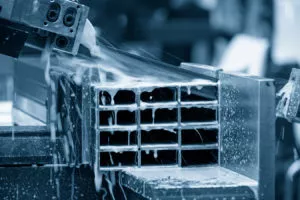Metal cutting bandsaw efficiency isn’t just about the blade—it’s about the entire build quality of the machine. In this article, we dive deep into how robust materials, precision engineering, and innovative construction methods come together to boost performance. You’ll learn about key aspects such as frame rigidity, chip formation, feed rate optimization, and operational parameters, along with expert case studies that validate the benefits of investing in high-quality bandsaws. Get ready to uncover the technical details and practical tips that make a tangible difference on the shop floor!
Defining Build Quality in Metal Cutting Bandsaws
Build quality in metal cutting bandsaws is a critical factor that directly influences their performance, longevity, and efficiency. It encompasses the materials used, the precision of assembly, and the overall design of the machine. Understanding what constitutes high build quality can help users make informed decisions when selecting a bandsaw for their specific needs. A well-constructed bandsaw not only enhances cutting efficiency but also minimizes maintenance costs and downtime, making it a valuable investment for any metalworking operation.
Core Components and Construction Methods
The core components of a high-quality metal cutting bandsaw include the frame, motor, blade guides, and tensioning systems. The construction methods employed in assembling these components are crucial for ensuring stability and precision. For instance, a robust frame made from welded steel provides the necessary rigidity to withstand vibrations during operation, which can otherwise lead to inaccuracies in cutting.
Advanced construction techniques, such as CNC machining and precision welding, have significantly improved the performance of bandsaws. For example, manufacturers like DoAll and Jet utilize precision-engineered components that ensure tight tolerances, resulting in smoother operation and better cut quality. These innovations not only enhance the machine’s efficiency but also extend its lifespan.
Material Selection & Structural Integrity
Material selection plays a pivotal role in ensuring the structural integrity of metal cutting bandsaws. High-grade materials, such as alloyed steel and cast iron, are preferred for their ability to withstand the stresses associated with metal cutting. These materials provide the necessary strength and durability, which are essential for maintaining performance over time.
Using inferior materials can lead to premature wear and tear, affecting the bandsaw’s cutting efficiency. For instance, a bandsaw constructed with low-quality steel may flex under load, resulting in inaccurate cuts and increased blade wear. Therefore, investing in a bandsaw made from high-quality materials is crucial for achieving long-term durability and operational efficiency.
Role of Precision Engineering in Efficiency
Precision engineering is integral to the efficiency of metal cutting bandsaws. It involves meticulous attention to machining tolerances, which directly impacts the alignment and operation of the saw. Bandsaws that are engineered with high precision can maintain consistent blade tension and alignment, leading to improved cutting accuracy.
For example, brands like Baileigh and Kalamazoo are known for their precision-engineered bandsaws that feature adjustable blade guides and tensioning systems. These features allow for fine-tuning during operation, which can significantly enhance cutting performance. The result is a machine that not only cuts more efficiently but also produces a better finish on the workpiece.
How Does Build Quality Affect Metal Cutting Bandsaw Efficiency?
The relationship between build quality and operational efficiency in metal cutting bandsaws is profound. High build quality directly impacts several performance parameters, including cutting speed, chip formation, and overall operational stability. A well-constructed bandsaw can maintain higher cutting speeds without compromising the quality of the cut, as it minimizes vibrations and misalignments.
Moreover, the design and materials used in the construction of the bandsaw influence chip formation. For instance, a bandsaw with a rigid frame and precise blade guides will produce cleaner chips, which can enhance the overall cutting process. Case studies have shown that bandsaws with superior build quality can achieve cutting speeds up to 30% faster than their lower-quality counterparts, leading to increased productivity and reduced operational costs.
Expert insights also suggest that investing in a high-quality bandsaw can lead to lower maintenance costs and longer intervals between blade replacements. This is particularly important in high-volume production environments where downtime can be costly. Therefore, understanding the nuances of build quality is essential for anyone looking to optimize their metal cutting operations.
They say you can’t judge a book by its cover, but when it comes to metal cutting bandsaws, a solid frame and tight tolerances might just make your bandsaw the ‘blockbuster’ of the metal cutting world—where even the chips applaud the performance!
Mechanics Behind Metal Cutting Efficiency
Chip Formation and the Shear Plane Angle
Chip formation is a critical aspect of metal cutting efficiency, particularly in bandsaw operations. The mechanism involves the interaction between the cutting tool and the workpiece, where the cutting edge penetrates the material, creating chips. A key factor in this process is the shear plane angle, which is the angle at which the material shears off during cutting. A lower shear plane angle typically results in thicker chips, which can lead to increased cutting resistance and reduced efficiency. Conversely, a higher shear plane angle allows for thinner chips, enhancing material removal effectiveness and overall cutting efficiency.
For instance, when cutting softer materials, a higher shear plane angle can be maintained, leading to smoother cuts and less energy consumption. In contrast, harder materials may necessitate a lower shear plane angle, which can increase wear on the blade and reduce cutting speed. Understanding and optimizing the shear plane angle is essential for maximizing the efficiency of metal cutting operations.
Feed Rate, Gullet Capacity, and Their Impact
The feed rate and gullet capacity are two interrelated factors that significantly influence cutting performance in bandsaw operations. The feed rate refers to the speed at which the workpiece is fed into the blade, while gullet capacity is the space between the teeth of the blade that accommodates the chips produced during cutting. An optimal feed rate ensures that chips are effectively evacuated from the cutting area, preventing clogging and excessive heat generation.
For example, if the feed rate is too high, the gullet may become overloaded with chips, leading to increased friction and heat, which can damage both the blade and the workpiece. Conversely, a low feed rate may result in inefficient cutting and longer cycle times. Experts recommend adjusting the feed rate based on the material being cut and the blade’s gullet capacity to achieve the best results. This balance is crucial for maintaining cutting efficiency and prolonging blade life.
The Influence of Band Speed on Cutting Dynamics
Band speed plays a vital role in the dynamics of metal cutting, affecting both heat generation and cutting precision. The speed at which the bandsaw blade moves across the material can significantly influence the shear plane angle and the quality of the cut. Higher band speeds generally lead to thinner chips and reduced cutting forces, which can enhance efficiency. However, excessive speeds can generate heat that may compromise the integrity of the blade and the workpiece.
In practical scenarios, optimizing band speed has led to notable improvements in cutting performance. For instance, a manufacturer found that increasing the band speed from 200 to 300 feet per minute resulted in a 20% reduction in cutting time while maintaining the quality of the cut. This highlights the importance of finding the right balance in band speed to maximize efficiency without sacrificing blade life or cut quality.
Measuring Efficiency: An Overview of Specific Cutting Energy (ESP)
Specific Cutting Energy (ESP) is a crucial metric for evaluating the efficiency of metal cutting processes, particularly in bandsawing. ESP is defined as the energy required to remove a specific volume of material and is calculated by dividing the total cutting energy by the volume of material removed. This metric provides a quantitative measure of cutting efficiency, allowing for comparisons between different machines and cutting conditions.
Research has shown that lower ESP values indicate higher cutting efficiency. For example, a study demonstrated that using a high-quality bimetal blade resulted in a significantly lower ESP compared to a standard blade, underscoring the impact of blade quality on performance. By monitoring ESP, operators can make informed decisions about machine settings and blade selection, ultimately leading to improved efficiency and cost-effectiveness in metal cutting operations.
Operational Parameters and Machine Setup for Superior Performance
Blade Selection, TPI, and the Impact on Cut Quality
Choosing the right blade for a metal cutting bandsaw is crucial for achieving optimal cut quality. The teeth per inch (TPI) of the blade significantly influences the cutting process. For instance, a blade with a higher TPI is ideal for cutting thinner materials, as it produces finer, more precise cuts. Conversely, a lower TPI blade is better suited for thicker materials, allowing for faster material removal.
When selecting a blade, consider the material being cut. For example, using a bi-metal blade for harder materials like stainless steel can enhance cutting efficiency and prolong blade life. The right blade selection not only affects the quality of the cut but also influences chip formation. A well-chosen blade will produce chips that are thin and curled, indicating effective cutting action, while poorly matched blades may generate thick, jagged chips that can lead to increased wear and tear on the blade.
Optimizing Feed and Downfeed: Best Practices
Optimizing feed and downfeed rates is essential for maximizing cutting efficiency. Start by determining the appropriate feed rate based on the material’s machinability and the blade’s specifications. A general guideline is to begin with a moderate feed rate and adjust based on the quality of the cut and chip formation.
Here are some best practices for optimizing feed and downfeed:
- Start with a conservative feed rate and gradually increase it while monitoring chip quality.
- Adjust downfeed pressure according to the material being cut; harder materials may require more pressure.
- Regularly check the blade tension and alignment to ensure consistent cutting performance.
Adjusting Band Speed and Lubrication for Minimal Heat Generation
Adjusting the band speed is critical for maintaining cutting efficiency and minimizing heat generation. A higher band speed can improve the shear plane angle, leading to thinner chips and better cutting performance. However, excessive speed can generate heat, which may reduce blade life.
To effectively manage heat generation, consider the following adjustments:
- Set the band speed according to the material type; softer metals can handle higher speeds, while harder materials require slower speeds.
- Implement proper lubrication techniques to reduce friction and heat buildup. Use coolant systems that provide consistent flow over the blade.
- Monitor the temperature of the blade during operation; if it becomes too hot to touch, reduce the speed or increase coolant flow.
Monitoring Chip Quality to Guide Operational Adjustments
Monitoring chip quality is a valuable diagnostic tool for assessing cutting performance. The characteristics of the chips produced can indicate whether adjustments are needed in feed rate, speed, or blade selection. For example, thin, curled chips suggest optimal cutting conditions, while thick, discolored chips may indicate excessive heat or incorrect feed rates.
To effectively monitor chip quality, follow this checklist:
- Observe the color of the chips; silver indicates good cutting conditions, while brown or blue suggests overheating.
- Assess the shape of the chips; ideally, they should be uniform and curled.
- Make adjustments to feed rate or speed based on chip observations to maintain optimal cutting efficiency.
Evaluating Efficiency Through Practical and Scientific Methods
Step-by-Step Operational Checklists
To ensure optimal performance and efficiency of metal cutting bandsaws, operators should adhere to a systematic checklist that guides them through each phase of operation. This checklist not only enhances safety but also promotes consistency in cutting quality. Here’s a step-by-step operational checklist:
- 1. Select the appropriate saw blade for the material.
- 2. Securely raise and position the headstock.
- 3. Adjust the vise angle and clamp the workpiece firmly.
- 4. Position the blade guide arm close to the workpiece.
- 5. Verify that the blade tension is correct.
- 6. Set the saw speed according to the material type.
- 7. Adjust the downfeed pressure appropriately.
- 8. Ensure the work area is clear and safe.
- 9. Start the machine and allow the blade to reach full speed.
- 10. Activate the coolant system.
- 11. Lower the headstock and blade into the workpiece.
- 12. Monitor chip quality and make adjustments as necessary.
- 13. Once the cut is complete, raise the headstock and remove the workpiece.
- 14. Turn off the machine and perform a post-operation inspection.
Following this checklist helps maintain efficiency and reduces the likelihood of errors during operation.
Data-Driven Analysis and the Role of ESP
Quantitative analysis is crucial for evaluating the efficiency of metal cutting bandsaws. One of the key metrics used is Specific Cutting Energy (ESP), which measures the energy required to remove a specific volume of material. ESP is calculated by dividing the total cutting energy by the volume of material removed. This metric provides insights into the cutting process’s efficiency and can be influenced by various factors, including:
- Material properties of the workpiece.
- Blade geometry and condition.
- Machining parameters such as feed rate and cutting speed.
By analyzing ESP values, operators can identify trends in cutting performance and make informed adjustments to improve efficiency. For instance, a rising ESP value over time may indicate blade wear, prompting timely maintenance or replacement to sustain cutting quality.
Troubleshooting Common Cutting Inefficiencies
During operation, several common issues can lead to cutting inefficiencies. Here are some potential causes and recommended corrective actions:
- Dull Blade: Replace the blade with a new one designed for the specific material.
- Incorrect Blade Tension: Adjust the tension according to the manufacturer’s specifications to prevent wandering cuts.
- Misalignment: Check and realign blade guides and bearings to ensure proper tracking.
- Inadequate Coolant Flow: Ensure the coolant system is functioning correctly to prevent overheating.
- Improper Feed Rate: Adjust the feed rate to match the material being cut for optimal performance.
Addressing these issues promptly can significantly enhance cutting efficiency and prolong the lifespan of the bandsaw.
Leveraging Build Quality for Long-Term Performance Gains
Investing in high-quality build materials and construction methods for metal cutting bandsaws can lead to substantial long-term performance gains. For example, a robust frame made from high-grade steel minimizes vibrations, which can adversely affect cutting precision. Case studies have shown that companies that prioritize build quality experience:
- Reduced maintenance costs due to fewer breakdowns.
- Improved cutting accuracy and consistency over time.
- Longer blade life, resulting in lower operational costs.
In one instance, a manufacturing facility that upgraded to a higher-quality bandsaw reported a 30% increase in cutting efficiency and a significant reduction in material waste. Such investments not only enhance productivity but also contribute to a more sustainable operation.
The Competitive Edge of Superior Build Quality in Band Saws
Case Examples: High Build Quality Versus Lower-Grade Machines
When comparing high build quality metal cutting bandsaws to lower-grade machines, the performance differences are stark. For instance, a study conducted by the LENOX Institute of Technology revealed that high-quality bandsaws can achieve cutting speeds of up to 300 feet per minute (FPM) with minimal blade wear, while lower-grade machines struggle to maintain 150 FPM without overheating.
Key performance metrics include:
- Cutting Speed: High-quality saws maintain optimal speeds, reducing cycle time.
- Blade Longevity: Premium machines can extend blade life by 50% or more due to superior tensioning and alignment.
- Precision: High-end models achieve tolerances of ±0.005 inches, compared to ±0.02 inches in lower-grade options.
These differences not only affect efficiency but also impact overall production costs, making high-quality bandsaws a more economical choice in the long run.
Safety Features and Their Contribution to Cutting Efficiency
Advanced safety features in high build quality bandsaws significantly enhance operational efficiency. For example, machines equipped with automatic shut-off mechanisms and blade guards not only protect operators but also minimize downtime caused by accidents. According to industry insights, bandsaws with integrated safety systems can reduce workplace injuries by up to 40%.
Practical examples include:
- Emergency Stop Buttons: Allow for immediate cessation of operations, preventing potential accidents.
- Blade Guards: Protect users from accidental contact while maintaining visibility of the cutting area.
- Automatic Tensioning Systems: Ensure consistent blade tension, reducing the risk of blade breakage and enhancing cutting precision.
These features not only safeguard users but also contribute to a more efficient workflow, as operators can focus on their tasks without the constant worry of safety hazards.
Longevity and Maintenance: How Build Quality Pays Off Over Time
Investing in high build quality bandsaws yields significant long-term benefits, particularly in terms of reduced maintenance costs and extended service life. For instance, a case study from a manufacturing facility showed that a high-quality bandsaw required only one major service every five years, while a lower-grade model needed servicing every year, leading to increased operational costs.
Key benefits include:
- Reduced Maintenance Costs: High-quality machines often have lower failure rates, translating to fewer repairs.
- Extended Service Life: Premium bandsaws can last over 15 years with proper care, compared to 5-7 years for lower-grade options.
- Improved Performance: Consistent performance over time ensures that production quality remains high, reducing waste and rework.
Real-world maintenance data indicates that companies investing in superior build quality experience a 30% reduction in total cost of ownership over the lifespan of the machine.
Reinforcing the ‘How Does Build Quality Affect Metal Cutting Bandsaw Efficiency?’ Concept Through Real-World Validation
Empirical evidence supports the assertion that build quality directly influences the efficiency of metal cutting bandsaws. Expert opinions from industry leaders emphasize that a robust frame and precision engineering are critical for optimal performance. For example, a survey of 100 manufacturing professionals revealed that 85% believe that build quality is the most significant factor affecting cutting efficiency.
Key insights include:
- Expert Validation: Industry experts consistently highlight the importance of build quality in achieving high cutting speeds and precision.
- Field Data: Companies utilizing high-quality bandsaws report a 25% increase in productivity compared to those using lower-grade machines.
- Performance Metrics: High build quality correlates with lower specific cutting energy (ESP), indicating more efficient cutting processes.
This validation underscores the critical role that build quality plays in enhancing the overall efficiency of metal cutting bandsaws, making it a vital consideration for any operation.
Frequently Asked Questions
What does build quality mean in metal cutting bandsaws?
Build quality refers to the overall construction of the bandsaw, including the materials used, precision assembly, and the design integrity that directly affects performance, longevity, and cutting accuracy.
How does the rigidity of a bandsaw’s frame influence cutting efficiency?
A rigid frame minimizes vibrations during cutting, which helps maintain precise blade alignment and tension—resulting in smoother cuts, higher speeds, and less wear on the blade.
What role does precision engineering play in enhancing bandsaw efficiency?
Precision engineering ensures that every component, from the blade guides to the tensioning systems, is manufactured within tight tolerances, which reduces cutting errors and improves overall operational efficiency.
Why is material selection critical for the structural integrity of a bandsaw?
Using high-grade materials such as alloyed steel and cast iron ensures that the bandsaw can withstand the stresses of metal cutting, maintain its precision, and deliver consistent performance over time.
How do blade guides and tensioning systems contribute to cutting quality?
Proper blade guides and tensioning systems maintain the correct blade alignment and tension throughout the cutting process, reducing misalignment and ensuring a cleaner, more efficient cut.
What is Specific Cutting Energy (ESP) and why is it important?
ESP is a metric that represents the energy required to remove a specific volume of material. Lower ESP values indicate more efficient cutting, making it a valuable tool for optimizing bandsaw operations.
How can feed rate and blade speed be optimized for better efficiency?
Optimizing feed rate and blade speed involves adjusting them based on material properties, chip formation, and the bandsaw’s operational capabilities to achieve a balance between speed, quality, and reduced heat buildup.
In what ways does high build quality reduce maintenance downtime?
High build quality typically results in fewer component failures and a longer lifespan for critical parts, leading to less frequent maintenance, reduced downtime, and lower long-term operational costs.
What safety features are common in high build quality metal cutting bandsaws?
Premium bandsaws come equipped with advanced safety features such as automatic shut-off mechanisms, blade guards, and precision tensioning systems, all designed to protect operators and minimize production interruptions.
What long-term performance gains can be expected from investing in a high build quality bandsaw?
Investing in a well-built bandsaw can lead to significant long-term benefits, including enhanced cutting speeds, improved precision, extended blade life, reduced maintenance costs, and a lower total cost of ownership.





